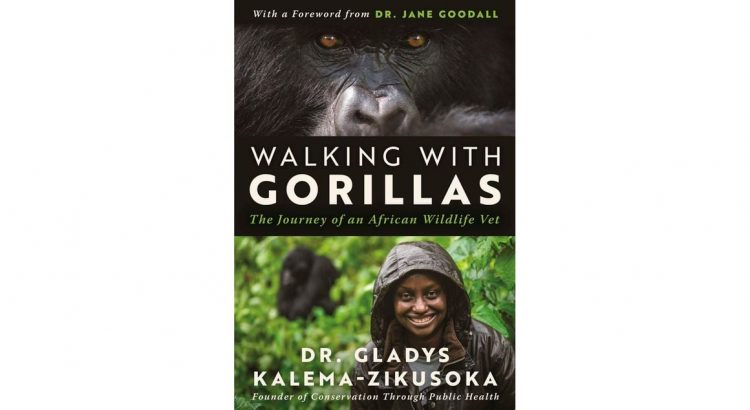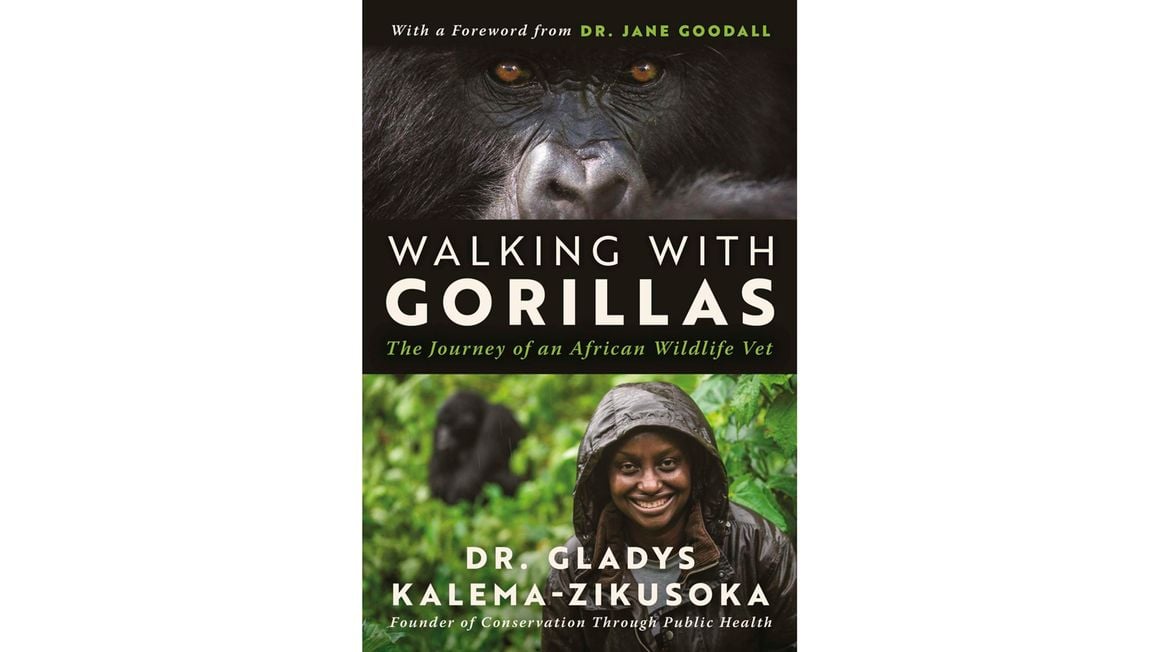Category: CTPH

Uganda’s first wildlife vet pens her journey to rescue gorillas
SOURCE: The East African

In tandem with the 20th anniversary of Conservation Through Public Health being celebrated now, is the amazing book published this year, Walking with Gorillas by Gladys Kalema-Zikusoka, who has made history by becoming Uganda’s first wildlife veterinarian and founder of CTPH, a globally acclaimed community programme ensuring the survival of the mountain gorillas of Bwindi Impenetrable National Park and the local communities.
A recipient of multiple international awards, Gladys narrates her story of carving out a career for herself in wildlife conservation that has her now recognised as an authority on mountain gorillas with her name on the Royal Veterinarian College (RVC) Wall of Achievement as one of the seven alumni with unique careers in the world. RVC is where she graduated from in the UK in 1996.
Life and work journey
When she began working as a wildlife vet in Uganda in the mid-1990s, there were 300 mountain gorillas in Bwindi and listed on the IUCN Red list as ”Critically endangered”.
Today Bwindi’s population of mountain gorillas is 459 and increasing, mostly thanks to CTPH. The global population (found only in Bwindi and the Virunga mountains straddling Rwanda and the Democratic Republic of Congo) is 1,063.
The last in a family of six siblings, Gladys was born into a family of political leaders on January 8, 1970, in Kampala with Idi Amin coming into power the following year.
Uganda descended into a decade of turmoil during Amin’s rule of terror marked by looting and bloodshed. Soon after her second birthday, her father, William Wilberforce Kalema, a former Cabinet minister under President Milton Obote, was abducted and murdered by Amin’s soldiers. She attributes much of her success to her mother Rhoda.
With an innate love for wildlife, despite growing up in a culture that sees animals having no souls, by age 12 Gladys had decided she wanted to be a vet. At 19, she enrolled at the Royal Veterinary College in the UK where she was the only woman of African origin in her class.
Her focus now was on not just becoming a vet but a wildlife vet to save Uganda’s decimated wildlife.
In an exciting time, she treats captive wild species in UK zoos, but the groundbreaking moment is when she attends a talk by Dr Barkley Hastings, the first vet to work on the mountain gorillas in Rwanda which fuels her growing interest in the primate.
As a student, her journey takes her to conducting research on chimpanzees and on mountain gorillas in Uganda. But it also coincides with one group of gorillas contracting scabies, the first disease outbreak discovered at the Uganda Wildlife Authority in 1996.
The group was raiding the farms on the edge of the forest and the farmers erected scarecrows dressed in their discarded clothes full of scabies-causing mites. Humans have built a resistance to scabies, but the gorillas have not.
This realisation was to change her life.
In 1996, Dr Gladys returned home as the country’s first wildlife vet and employed at the Uganda Wildlife Authority to set up the veterinarian unit.
Read: Exciting hike through thick Bwindi forest
Despite the lack of funds, her passion blazes through the pages of how she struggles to treat wild animals in the wild and with each success, she convinces donors to fund the unit that eventually become fully fledged.
After four years at UWA, Gladys realised that if the mountain gorillas of the Bwindi Impenetrable Forest were to survive, the marginalised community living in poverty alongside the gorillas had to be fully involved with healthcare topping the list.
It led her to found Conservation Through Public Health in 2003 that has become a trailblazer in the world of wildlife and human conservation — despite being told by people that she would never attract funding because she was black.
The One Health model, later adopted by the United Nations as the One Health Approach focuses on people, animals and the environment.
When Gladys founded CTPH, her focus was on preventing zoonotic diseases transmitted between people and the gorillas working with the Village Health and Conservation team.
Today, the programme has expanded phenomenally, providing the villagers with access to education and health-care centres where there is treatment for scabies, HIV/Aids and family planning including establishing tele-centres and engaging the coffee farmers in fair trade coffee under the brand Kanyonyi, the silverback who was her favourite gorilla.
Village counselling
With the gorilla population increasing and the land remaining static, villagers are counselled on family planning and on re-investing the money to become self-sufficient and provide education for children.
Read: Uganda’s gorilla population increases
In an interview, Gladys states: “Big families means many mouths to feed, increasing land wrangles and forest fragmentation.”
The Covid pandemic brought gorilla tourism to a grinding stop. It saw poaching for bush meat (to put food on the table) re-surface resulting in the death of one gorilla.
After successful launches in Uganda, the US and UK, Walking with Gorillas will be launched in Nairobi in the coming months with Gladys in attendance. Published by Arcade Publishing 2023, the book is available on Amazon.
Since then, there’s been no gorilla killed in a snare.
Big win: July 2022, at the International Union of Conservation (IUCN) meeting in Rwanda, CTPH presented a policy brief with International Gorilla Conservation Programme and the Africa CSO Biodiversity Alliance on responsible great ape tourism, which was adopted, laying the protocol for gorilla tourism in the wake of the Covid pandemic to ensure the lives of both the ape and the human.
After successful launches in Uganda, the USA and the UK, Walking with Gorillas will be launched in Nairobi in the coming months with Dr Gladys in attendance.
Published by Arcade Publishing 2023, it is available on Amazon.

Uganda: Dr. Gladys Kalema Zikusoka Pens Walking With Gorillas About Life As an African Wildlife Vet
SOURCE: ALL AFRICA
Dr. Gladys Kalema Zikusoka’s memoir, “Walking with Gorillas”, is a testament to her unwavering dedication to wildlife conservation.
Dr Kalema has made history by becoming Uganda’s first wildlife veterinarian and founder of the non-governmental organisation, Conservation Through Public Health (CTPH).
This is a globally acclaimed community programme ensuring the survival of the mountain gorillas.
Her memoir is divided into four parts, each revealing a crucial aspect of her journey towards becoming a wildlife veterinarian and founder of CTPH.
In the first section of the book, Dr. Kalema recounts how the assassination of her father influenced her decision to pursue a career in veterinary medicine.
Despite cultural beliefs that discouraged girls from studying veterinary medicine, Dr. Kalema overcame several challenges to pursue her dream. Her journey to becoming a wildlife veterinarian began with Wildlife Clubs of Uganda, where she first learned about the mountain gorillas of Bwindi.
The second part of the memoir describes Dr. Kalema’s experiences in wildlife veterinary medicine. She recounts how she tackled significant challenges in her job, such as relocating elephants and treating a mysterious skin disease affecting giraffes.
However, it was the outbreak of an unusual skin disease that threatened the lives of mountain gorillas that inspired her to start an NGO seven years later that would address human health and seek to create solutions in which human and gorilla communities can coexist in harmony.
This part of the memoir takes readers through Dr. Kalema’s decision to establish Conservation through public health as an NGO in Uganda, detailing the successes and challenges she faced in promoting understanding for the need for an integrated response to conservation and health.
One of the highlights is Dr. Kalema’s recognition as an entrepreneur and leader in her field, including serving on the boards of Uganda Wildlife Education Centre, and Uganda Wildlife Authority.
The final section of the memoir focuses on the future of conservation, offering insights on ways to support it in sustainable ways that aren’t dependent on donors. This part emphasises the importance of ecotourism and highlights the conservation and social contributions of CTPH’s social enterprise, Gorilla Conservation Coffee. The section also addresses the impact of the Covid-19 pandemic on conservation efforts and wildlife populations and Dr. Kalema Zikusoka’s personal battles with the virus.
“Walking with Gorillas” highlights the critical role of wildlife conservation in our environment’s sustainability and the importance of One Health approaches.
Dr. Kalema said the government needs to put more money into conservation and tourism, adding that tourism has helped greatly in shaping the industry.
“Conservation is about being ready to get your shoes dirty and enjoy wildlife,” she said.
The US Ambassador to Uganda, Natalie Brown who was the guest of honour during the launch of the book, expressed her love for animals and congratulated Dr. Kalema upon publishing her memoir.
“It’s an engaging lesson for all and useful information on the importance of conservation and its connection to health. The US is proud of its work over the years to support efforts to preserve the environment and Uganda’s 🇬’s biodiversity for future generations,” she said.
The Chief Executive Officer of the Uganda Tourism Board, Lilly Ajarova, said the book “Walking with Gorillas” is a reflection on Dr. Kalema’s upbringing in Uganda and career as a wildlife veterinarian.
“We are very excited that we have this publication as another tool that will be able to create awareness about Uganda,” she said.
The executive director of Uganda Wildlife Authority (UWA), Sam Mwandha, congratulated Dr. Kalema for writing the book, noting that it is a marketing tool for the national and for the wildlife in Uganda.
Gorillas remain the single most important item on Uganda’s tourism menu according to the Uganda Tourism Board
With conservation taking the mountain gorilla off the edge of extinction, the mantle is still left to the country to keep things from slipping back.

Tourism conservation takes gorillas from extinction
SOURCE: NTV
Gorillas remain the single most important item on Uganda’s tourism menu according to the Uganda Tourism Board. With conservation taking the mountain gorilla off the edge of extinction, the mantle is still left to the country to keep things from slipping back. This was part of the launch of the book “walking with Gorillas” authored by Dr. Gladys Kalema a renown Gorilla conservationist.

Uganda’s first wildlife vet pens her journey to rescue gorillas
SOURCE: The EastAfrican

In tandem with the 20th anniversary of Conservation Through Public Health being celebrated now, is the amazing book published this year, Walking with Gorillas by Gladys Kalema-Zikusoka, who has made history by becoming Uganda’s first wildlife veterinarian and founder of CTPH, a globally acclaimed community programme ensuring the survival of the mountain gorillas of Bwindi Impenetrable National Park and the local communities.
A recipient of multiple international awards, Gladys narrates her story of carving out a career for herself in wildlife conservation that has her now recognised as an authority on mountain gorillas with her name on the Royal Veterinarian College (RVC) Wall of Achievement as one of the seven alumni with unique careers in the world. RVC is where she graduated from in the UK in 1996.
Life and work journey
When she began working as a wildlife vet in Uganda in the mid-1990s, there were 300 mountain gorillas in Bwindi and listed on the IUCN Red list as ”Critically endangered”.
Today Bwindi’s population of mountain gorillas is 459 and increasing, mostly thanks to CTPH. The global population (found only in Bwindi and the Virunga mountains straddling Rwanda and the Democratic Republic of Congo) is 1,063.
The last in a family of six siblings, Gladys was born into a family of political leaders on January 8, 1970, in Kampala with Idi Amin coming into power the following year.
Uganda descended into a decade of turmoil during Amin’s rule of terror marked by looting and bloodshed. Soon after her second birthday, her father, William Wilberforce Kalema, a former Cabinet minister under President Milton Obote, was abducted and murdered by Amin’s soldiers. She attributes much of her success to her mother Rhoda.
With an innate love for wildlife, despite growing up in a culture that sees animals having no souls, by age 12 Gladys had decided she wanted to be a vet. At 19, she enrolled at the Royal Veterinary College in the UK where she was the only woman of African origin in her class.
Her focus now was on not just becoming a vet but a wildlife vet to save Uganda’s decimated wildlife.
In an exciting time, she treats captive wild species in UK zoos, but the groundbreaking moment is when she attends a talk by Dr Barkley Hastings, the first vet to work on the mountain gorillas in Rwanda which fuels her growing interest in the primate.
As a student, her journey takes her to conducting research on chimpanzees and on mountain gorillas in Uganda. But it also coincides with one group of gorillas contracting scabies, the first disease outbreak discovered at the Uganda Wildlife Authority in 1994.
The group was raiding the farms on the edge of the forest and the farmers erected scarecrows dressed in their discarded clothes full of scabies-causing mites. Humans have built a resistance to scabies, but the gorillas have not.
This realisation was to change her life.
In 1996, Dr Gladys returned home as the country’s first wildlife vet and employed at the Uganda Wildlife Authority to set up the veterinarian unit.
Read: Exciting hike through thick Bwindi forest
Despite the lack of funds, her passion blazes through the pages of how she struggles to treat wild animals in the wild and with each success, she convinces donors to fund the unit that eventually become fully fledged.
After four years at UWA, Gladys realised that if the mountain gorillas of the Bwindi Impenetrable Forest were to survive, the marginalised community living in poverty alongside the gorillas had to be fully involved with healthcare topping the list.
It led her to found Conservation Through Public Health in 2003 that has become a trailblazer in the world of wildlife and human conservation — despite being told by people that she would never attract funding because she was black.
The One Health model, later adopted by the United Nations as the One Health Approach focuses on people, animals and the environment.
When Gladys founded CTPH, her focus was on preventing zoonotic diseases transmitted between people and the gorillas working with the Village Health and Conservation team.
Today, the programme has expanded phenomenally, providing the villagers with access to education and health-care centres where there is treatment for scabies, HIV/Aids and family planning including establishing tele-centres and engaging the coffee farmers in fair trade coffee under the brand Kanyonyi, the silverback who was her favourite gorilla.
Village counselling
With the gorilla population increasing and the land remaining static, villagers are counselled on family planning and on re-investing the money to become self-sufficient and provide education for children.
Read: Uganda’s gorilla population increases
In an interview, Gladys states: “Big families means many mouths to feed, increasing land wrangles and forest fragmentation.”
The Covid pandemic brought gorilla tourism to a grinding stop. It saw poaching for bush meat (to put food on the table) re-surface resulting in the death of one gorilla.
After successful launches in Uganda, the US and UK, Walking with Gorillas will be launched in Nairobi in the coming months with Gladys in attendance. Published by Arcade Publishing 2023, the book is available on Amazon.
Since then, there’s been no gorilla killed in a snare.
Big win: July 2022, at the International Union of Conservation (IUCN) meeting in Rwanda, CTPH presented a policy brief with International Gorilla Conservation Programme and the Africa CSO Biodiversity Alliance on responsible great ape tourism, which was adopted, laying the protocol for gorilla tourism in the wake of the Covid pandemic to ensure the lives of both the ape and the human.
After successful launches in Uganda, the USA and the UK, Walking with Gorillas will be launched in Nairobi in the coming months with Dr Gladys in attendance.
Published by Arcade Publishing 2023, it is available on Amazon.